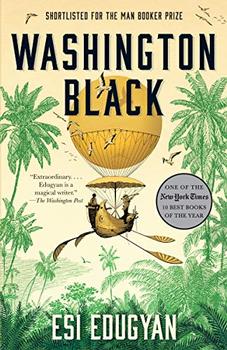Summary | Excerpt | Reading Guide | Reviews | Beyond the Book | Read-Alikes | Genres & Themes | Author Bio

This article relates to Washington Black
Esi Edugyan's Washington Black becomes an apprentice to a man of science and cultivates a far-reaching understanding of scientific and mathematical concepts – something that would never have been expected of a child born into slavery. He contributes his great mind to the aeronautical pursuits of his teacher as well as to the idea of an aquarium for the people of London. (See more about the Publica Aquaria)
 Nobody would be surprised to learn that, until very recently, science was the realm of the white male. Even now, STEM fields (science, technology, engineering and mathematics) struggle to diversify. Yet it is clear that diversity is key to a robust and effective world of science. The most basic example of a lack of diversity, according to an article in Nature: International Journal of Science, is the fact that much of the tissue used in screening drugs and medical therapies in the Western world comes from white subjects. This makes no sense given that a variance in ethnicity can result in very different reactions to medication.
Nobody would be surprised to learn that, until very recently, science was the realm of the white male. Even now, STEM fields (science, technology, engineering and mathematics) struggle to diversify. Yet it is clear that diversity is key to a robust and effective world of science. The most basic example of a lack of diversity, according to an article in Nature: International Journal of Science, is the fact that much of the tissue used in screening drugs and medical therapies in the Western world comes from white subjects. This makes no sense given that a variance in ethnicity can result in very different reactions to medication.
Diversity specifically impacts the science category of STEM. Science strives to be objective – for example, blind peer reviews are sometimes done on a research study, presumably so that good ideas come out on top regardless of who submits them. Yet there are still limits on the people who are actually able to submit those ideas. According to the Office of the Chief Economist of the US Department of Commerce, as of 2017, only 24% of STEM jobs were held by women in the United States. The percentage drops sharply when you look at women of color – only 2% for Hispanic women and 2% for African American women.
 If science is meant to serve the entire world through building greater knowledge and understanding, then the scientific community should look like the people it seeks to know and understand. When an issue is approached with a variety of contributors, a solution tends to be reached faster, obstacles are better anticipated and addressed, and the end result will serve a greater population. Yet the National Academy of Sciences itself admits that minority populations are "a vastly underused resource and a lost opportunity for meeting our nation's technology needs." Achieving greater diversity in the scientific community is a large and complex undertaking. It is not enough to simply hire with a specific quota in mind. Increasing diversity means making STEM programs more accessible to groups that are currently underrepresented, it means building empowered communities within the workplace, and providing appropriate resources.
If science is meant to serve the entire world through building greater knowledge and understanding, then the scientific community should look like the people it seeks to know and understand. When an issue is approached with a variety of contributors, a solution tends to be reached faster, obstacles are better anticipated and addressed, and the end result will serve a greater population. Yet the National Academy of Sciences itself admits that minority populations are "a vastly underused resource and a lost opportunity for meeting our nation's technology needs." Achieving greater diversity in the scientific community is a large and complex undertaking. It is not enough to simply hire with a specific quota in mind. Increasing diversity means making STEM programs more accessible to groups that are currently underrepresented, it means building empowered communities within the workplace, and providing appropriate resources.
There are countless examples of non-majority scientists who have contributed vital and unique work to the field of science. Consider Benjamin Banneker, a self-educated black man, who penned extraordinary medical, mathematical and astronomic almanacs. Or what about Katherine Johnson (who very few people knew about until the movie Hidden Figures came out in 2016), a black woman known as a "human computer" because she was able to do complex calculations in her head? She was deeply involved with some of NASA's most important missions in the 1960s.
Woodcut portrait of Benjamin Banneker, in title page of a Baltimore edition of his 1795 Pennsylvania, Delaware, Maryland, and Virginia Almanac.
Katherine Johnson at NASA in 1966.
Filed under Medicine, Science and Tech
![]() This "beyond the book article" relates to Washington Black. It originally ran in October 2018 and has been updated for the
April 2019 paperback edition.
Go to magazine.
This "beyond the book article" relates to Washington Black. It originally ran in October 2018 and has been updated for the
April 2019 paperback edition.
Go to magazine.
Your guide toexceptional books
BookBrowse seeks out and recommends the best in contemporary fiction and nonfiction—books that not only engage and entertain but also deepen our understanding of ourselves and the world around us.